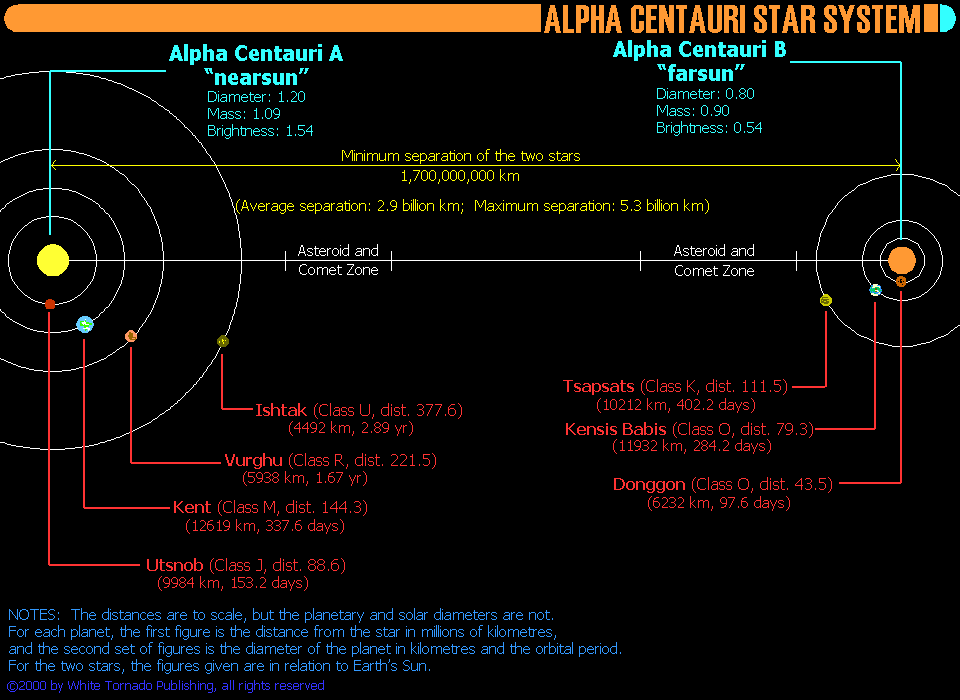ALPHA CENTAURI SYSTEM
The Alpha Centauri system is a triple star system. The two main stars are Alpha Centauri A and Alpha Centauri B, while the third star is Alpha Centauri C or Proxima Centauri. The two main stars are in close orbit around their common centre of gravity, while Proxima Centauri is a dim red dwarf star that orbits some distance from the two other stars. In fact, it is not absolutely certain that Proxima Centauri is part of the system, although it seems likely since its proper motion is the same as that of the main stars. At a distance of one tenth of a light year from the main stars, Proxima Centauri takes hundreds of thousands of years to complete one orbit. It has no bearing in terms of gravity or other influences in the solar systems of the two main stars. In fact, Proxima Centauri is not even visible with the naked eye from the surface of Kent.
The larger star is Alpha Centauri A, a G2-class star that is the near double of Earth's sun in terms of size, luminosity, energy output and most important, stability. It is slightly larger in terms of radius (1.2 times the sun's radius) and mass (1.09 times the sun's mass), so its brightness is somewhat larger, 1.54 times that of the sun. The second star, Alpha Centauri B, is a class K1 star, an orange dwarf, that is somewhat dimmer and cooler than the first star. It's mass is 0.90 that of Earth's sun and its diameter is 0.80 that of the sun. As a result, it is somewhat dimmer and cooler, with only 0.44 times the brightness of the sun. It is also stable. The two stars orbit around a common centre of gravity, the barycentre, and complete one orbit in a span of eighty years. The orbits of the two stars around the barycentre is elliptical. On average, the two stars are separated by 2.9 billion kilometres, roughly the distance that Uranus is from the sun. However, because of the elliptical nature of their orbits, the stars can come as close as 1.7 billion kilometres and be separated by a distance as great as 5.3 billion kilometres. Because the two stars formed from the same cloud of gas and dust that began to contract and spin six billion or more years ago, the planetary systems of both stars are within the same plane as the orbits of the two stars. With two stars that close to each other, planets can only form and have stable orbits only if they fall within one quarter of the minimum distance between the stars. In the Alpha Centauri system, all the planets are within 425 million kilometres of the stars. Planets that would have formed outside of that range would have had unstable orbits and over time, would have either been ejected from the system altogether or had their orbits adjusted to the point that they fall within the limit. This distance is sufficient to allow class-M planets to form and have stable orbits.
Alpha Centauri A has four planets, and they are given in the table below. All the planets are Earth-sized or smaller. A Alpha Centauri II is the largest planet, while the other three are more Mars-sized or Mercury-sized worlds. The system contains no gas-giant stars, and the number of satellites is very limited, with only Ishtak having one small satellite.
| Name | Distance (km) | Diameter (km) | Rotation | Revolution | Satellites | Classification | |
|---|---|---|---|---|---|---|---|
| I | Utsnob | 88,600,000 | 9984 | 12.2 days | 153.2 days | 0 | Class J |
| II | Kent | 144,325,000 | 12619 | 24.72 hours | 337.6 days | 0 | Class M |
| III | Vurghu | 221,526,000 | 5938 | 22.67 hours | 1.67 years | 0 | Class R |
| IV | Ishtak | 377,624,000 | 4492 | 2.25 days | 2.89 years | 1 | Class U |
| Name | Distance (km) | Diameter (km) | Rotation | Revolution | Satellites | Classification | |
|---|---|---|---|---|---|---|---|
| I | Donggon | 43,465,000 | 6232 | 146.4 days | 97.6 days | 0 | Class V |
| II | Kensis Babis | 79,325,000 | 11932 | 31.2 hours | 284.2 days | 1 | Class O |
| III | Tsapsats | 111,530,000 | 10212 | 121.5 days | 402.2 days | 1 | Class K |

The double-star Alpha Centauri system showing the distances to scale
A number of small asteroids have been captured by the two stars, and have orbits that are circular and very close to the star. In the case of Alpha Centauri A, one such asteroid orbits at a distance of eleven million kilometres. In the beginning, mankind assumed that these small asteroids were planets and numbered them and the three main worlds accordingly. Thus, Kent was actually A Alpha Centauri VIII in this system. However, since the Kentyans themselves do not count those small bodies as planets (the largest being only twenty-seven kilometres in diameter), the Earth-derived nomenclature was eventually dropped and now, everybody agrees that Alpha Centauri A has only four "real" planets.